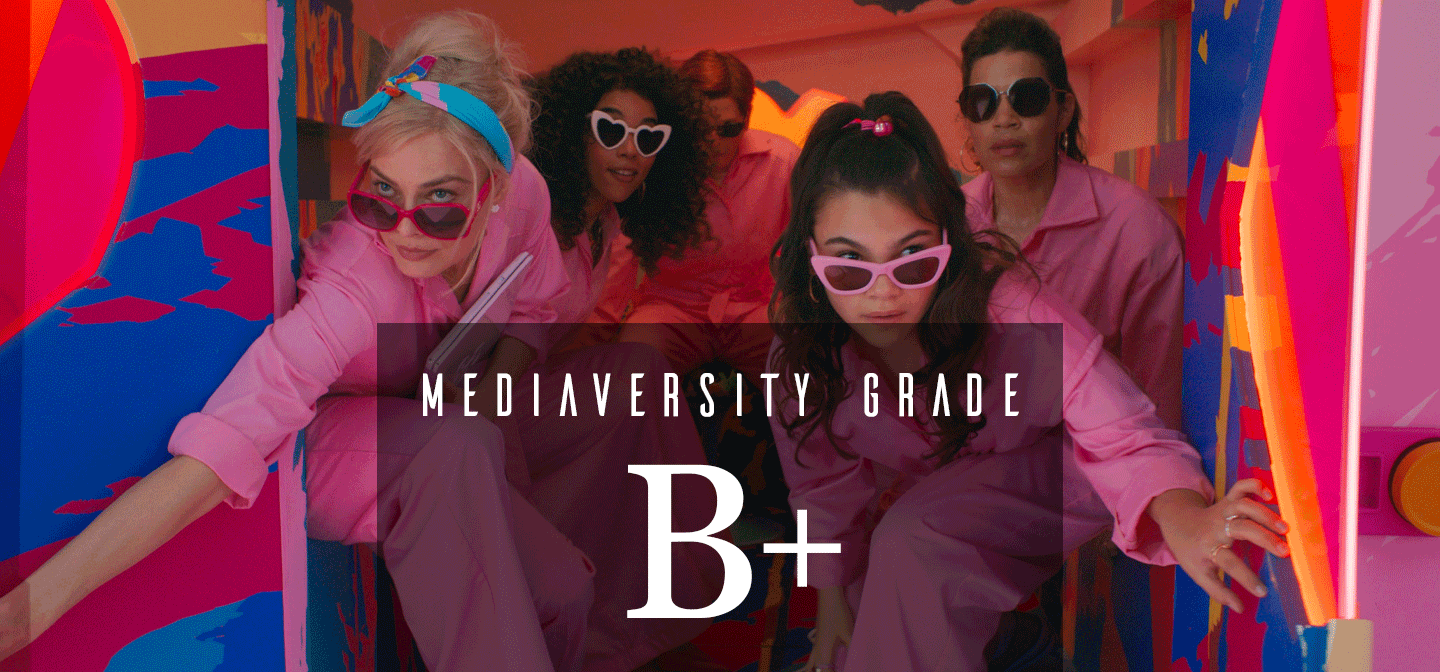Barbie
“Margot Robbie plays the main character in Barbie, but it’s Latina women—America Ferrera’s Gloria and onscreen daughter Sasha—that tug at the heartstrings the most.”
Title: Barbie (2023)
Director: Greta Gerwig 👩🏼🇺🇸
Writers: Greta Gerwig 👩🏼🇺🇸 and Noah Baumbach 👨🏼🇺🇸
Reviewed by Li 👩🏻🇺🇸
Technical: 3.5/5
As America Ferrera’s character vents onscreen, women have to be everything—pretty but not too pretty, rich but can’t ask for money, a firm leader but liked by everyone—and in many ways, Greta Gerwig’s Barbie had to walk the very same (and impossible) tightrope. Be a massive franchise hit that sends droves of fans to Barbie-themed merch while appealing to feminist sensibilities! Be as fun and flirty as a summer blockbuster, but hold onto indie values of authenticity and inclusion!
Defying the odds, Barbie mostly succeeds. It’s a joy to watch Gerwig get studio money and corporate blessings to make something so weird, for one thing. Human Ken dolls face off in a waterfront battle royale, armed with lacrosse sticks and toy steeds. Men in suits chase Barbie in a highly choreographed dance through a self-referential Mattel office, as a Warner Bros. Discovery building looms in the background. All the while, kitschy details and throwbacks to Barbie lore suffuse the film, making it a blaring homage (or commercial) to the iconic doll.
But when it comes to storytelling, Gerwig and co-writer Noah Baumbach spread themselves thin. Plots and relationships abound, as viewers split their attention between the reconciliation of an estranged mother and daughter, the romantic mismatch between Stereotypical Barbie (Margot Robbie) and Ken (Ryan Gosling), a macho rivalry between Gosling’s Ken and Simu Liu’s Ken, and a plethora of other tangents. A lot of these breadcrumbs feel compelling; I really wanted to know what other twisted Barbie designs Mattel secretary Gloria (Ferrera) had in store beyond Cellulite Barbie and I Can’t Stop Thinking About Death Barbie. And the schism she experiences with her surly tween daughter, Sasha (Ariana Greenblatt), had all the potential of becoming a true tearjerker. But these pieces never get fleshed out.
On its face, Barbie really does do it all. But in that pursuit of widespread appreciation, it never gels into anything more than an interesting thought experiment and campy comedy.
Gender: 5/5
Does it pass the Bechdel Test? YES
During the film, Barbie and Ken journey to the Real World and discover the scourge of patriarchy. The script proceeds to follow Barbie (and her fellow Barbies) as they fight the unfair system—a simplistic way to telegraph its feminism, but one that certainly doesn’t waffle.
Women rule Barbie Land, the alternate universe where Barbie and Ken dolls live in blissful ignorance of the unglamorous reality where the rest of us schmucks live. And when the Kens grasp the corruptive power of patriarchy, it’s scripted as a horrific coup: Ken takes over Barbie’s Dreamhouse and dubs his new alpha male abode “Ken's Mojo Dojo Casa House,” installing a swinging saloon door and high bar for pull-ups. All the Barbies in Barbie Land get brainwashed and have to be “deprogrammed,” one at a time, by litanies of truth bombs delivered by Kate McKinnon’s Weird Barbie.
To an adult, this overt ridiculing of toxic and insecure men has all the subtlety of a wrecking ball. But for the brand’s target demographic—kids and tweens who might be learning about these systemic issues for the first time—it’s possible that Gerwig has crafted the perfect megaphone: one that’s loud, clear, and meant to be a starting point for further discussions, rather than an end-all-be-all masterpiece of feminist theory.
Race: 4/5
White Australian and Canadian actors—Robbie and Gosling, respectively—see the majority of screen time in Barbie. But in a welcome shift from Gerwig’s previous films, which focused on mostly white casts (Lady Bird, Little Women), Barbie includes women of color into key roles.
Yes, Robbie’s Stereotypical Barbie sees the largest character transformation. But it’s the relationship between Gloria and daughter Sasha, both played by multiracial Latina actors, that tugs at the heartstrings the most. And it continues to be wonderful seeing Asian men—long portrayed as punchlines or sexual predators in Hollywood—cast as attractive jocks, as we see with Ken’s main competitor, played by Chinese Canadian actor Liu. In smaller but still positive roles, Black actor Issa Rae plays President Barbie and Alexandra Shipp (who’s biracial Black and white) is Author Barbie. And other Kens in minor roles include Ncuti Gatwa (who is Rwandan Scottish) and Kingsley Ben-Adir (English and whose mother is of Trinidadian descent).
Bonus for LGBTQ: +0.25
Trans model and actor Hari Nef plays one of the film’s many Barbies, appearing in a few group scenes. The Barbie brand is synonymous with idealized women, for better or for worse. But in this case, it’s for the better as the film easily asserts that being a trans woman is being an ideal woman. In addition, McKinnon, who is openly lesbian, plays a key role as the Barbie that rallies the troops after the Kens have taken over Barbie Land.
Bonus for Body Diversity: +0.00
Bonus for Disability: +0.00
Although their inclusions aren’t substantial enough to warrant bonus points, viewers can also spot body diversity among the cast of Barbies, plus a couple of disabled Barbies. A wheelchair-user dances a solo during a glitzy disco sequence. And in a blink-and-you’ll-miss-it shot, a Barbie with a prosthetic arm stands behind President Barbie during a scene in her office.
Mediaversity Grade: B+ 4.25/5
Although it’s hampered by a lack of attention to its most interesting narrative—the broken relationship between Gloria and Sasha—Barbie still manages to land a difficult dismount. It delivers a culture-making moment for Mattel, but thanks to Gerwig’s indie pedigree, stays subversive enough for moviegoers and film critics alike to come away happy.




